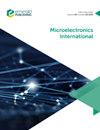用于柔性微流体装置的纸基板结构分析
IF 0.8
4区 工程技术
Q4 ENGINEERING, ELECTRICAL & ELECTRONIC
引用次数: 0
摘要
目的本文的目的是预测一种合适的具有高毛细管压力的纸基板,该基板具有随后流体向前扭曲的趋势,用于微流体器件的制造应用。设计/方法/方法本实验是在GE Healthcare Life Sciences生产的WhatmanTM 1级、WhatmanTM色谱和硝化纤维素纸样品上进行的。通过扫描电子显微镜和ImageJ软件对纸张样品的表面性质进行了结构表征。通过傅立叶变换红外分析对样品表面的官能团进行了识别。还使用COMSOL Multiphysics工具的“多孔介质中的多相流动”模块进行了有限元分析,该模块结合了达西定律和多孔介质界面中的相输运。实验发现,用于柔性微流体装置应用的纸基板必须具有大量的内部(纤维内和纤维间)孔隙,这些孔隙具有较少的空隙空间(外部孔隙),这些空隙空间具有较高的毛细管压力,以通过狭窄的纸纤维通道将流体向前推进。独创性/价值表面结构在纸张制造、印刷工艺和微流体应用等多种应用中对纸张基材的利用具有动态影响。本文章由计算机程序翻译,如有差异,请以英文原文为准。
Structural analysis of paper substrate for flexible microfluidics device application
Purpose
The purpose of this paper is to predict a suitable paper substrate which has high capillary pressure with the tendency of subsequent fluid wrenching in onward direction for the fabrication of microfluidics device application.
Design/methodology/approach
The experiment has been done on the WhatmanTM grade 1, WhatmanTM chromatography and nitrocellulose paper samples which are made by GE Healthcare Life Sciences. The structural characterization of paper samples for surface properties has been done by scanning electron microscope and ImageJ software. Identification of functional groups on the surface of samples has been done by Fourier transform infrared analysis. A finite elemental analysis has also been performed by using the “Multiphase Flow in Porous Media” module of the COMSOL Multiphysics tool which combines Darcy’s law and Phase Transport in Porous Media interface.
Findings
Experimentally, it has been concluded that the paper substrate for flexible microfluidic device application must have large number of internal (intra- and interfiber) pores with fewer void spaces (external pores) that have high capillary pressure to propel the fluid in onward direction with narrow paper fiber channel.
Originality/value
Surface structure has a dynamic impact in paper substrate utilization in multiple applications such as paper manufacturing, printing process and microfluidics applications.
求助全文
通过发布文献求助,成功后即可免费获取论文全文。
去求助
来源期刊

Microelectronics International
工程技术-材料科学:综合
CiteScore
1.90
自引率
9.10%
发文量
28
审稿时长
>12 weeks
期刊介绍:
Microelectronics International provides an authoritative, international and independent forum for the critical evaluation and dissemination of research and development, applications, processes and current practices relating to advanced packaging, micro-circuit engineering, interconnection, semiconductor technology and systems engineering. It represents a current, comprehensive and practical information tool. The Editor, Dr John Atkinson, welcomes contributions to the journal including technical papers, research papers, case studies and review papers for publication. Please view the Author Guidelines for further details.
Microelectronics International comprises a multi-disciplinary study of the key technologies and related issues associated with the design, manufacture, assembly and various applications of miniaturized electronic devices and advanced packages. Among the broad range of topics covered are:
• Advanced packaging
• Ceramics
• Chip attachment
• Chip on board (COB)
• Chip scale packaging
• Flexible substrates
• MEMS
• Micro-circuit technology
• Microelectronic materials
• Multichip modules (MCMs)
• Organic/polymer electronics
• Printed electronics
• Semiconductor technology
• Solid state sensors
• Thermal management
• Thick/thin film technology
• Wafer scale processing.
 求助内容:
求助内容: 应助结果提醒方式:
应助结果提醒方式:


